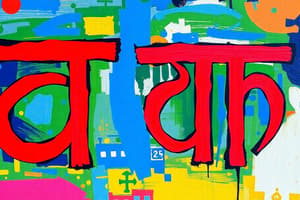Podcast
Questions and Answers
Hindi me kitne swar akshar hote hain?
Hindi me kitne swar akshar hote hain?
- 4
- 6
- 5 (correct)
- 7
Kya sandhi ka udaharan diya gaya hai?
Kya sandhi ka udaharan diya gaya hai?
- 'sa' + 'pa'
- 'ka' + 'ta' (correct)
- 'ga' + 'na'
- 'ma' + 'gha'
Hindi me vyanjan akshar ko ek shabd me milane par kitne akshar ki sima hoti hai?
Hindi me vyanjan akshar ko ek shabd me milane par kitne akshar ki sima hoti hai?
- 5
- 3
- 4
- 2 (correct)
'Krodh' shabd ko kis tarah likha jata hai?
'Krodh' shabd ko kis tarah likha jata hai?
Kis prakar ke aksharon ka samuh naya shabd banate hain?
Kis prakar ke aksharon ka samuh naya shabd banate hain?
कितने अक्षरों से मिलकर देवनागरी लिपि बनती है?
कितने अक्षरों से मिलकर देवनागरी लिपि बनती है?
देवनागरी लिपि का मुख्य स्वर क्या है?
देवनागरी लिपि का मुख्य स्वर क्या है?
क्या 'व्यंजन' कहलाने वाले चिन्ह हमें किस बात के बारे में बताते हैं?
क्या 'व्यंजन' कहलाने वाले चिन्ह हमें किस बात के बारे में बताते हैं?
'अक्षर' का मतलब क्या होता है?
'अक्षर' का मतलब क्या होता है?
किसकी पहली 'स' से मिलकर 'ह' आता है?
किसकी पहली 'स' से मिलकर 'ह' आता है?
Flashcards are hidden until you start studying
Study Notes
Introduction to Hindi Alphabet and Grammar
Hindi is one of the most widely spoken languages in India and serves as the official language in several states. It's also used by many people in neighboring countries like Pakistan, Nepal, Bangladesh, and Mauritius. In addition to its diverse usage, Hindi has a unique script and set of grammatical rules that make it distinct from other Indo-Aryan languages. This section will focus on exploring these aspects of Hindi — specifically, the Devanagari script and its basic phonetic structure, as well as some fundamental features of Hindi grammar.
The Devanagari Script
Devanagari is the primary script used for writing Hindi. Developed over centuries, this script consists of 17 vowels and 36 consonants. While there have been attempts to simplify the script with a more modern and international approach, such as Romanization or transliteration, the traditional Devanagari script remains prevalent among speakers because of its ability to convey nuances present only through the original script. For instance, diacritic marks called 'vyanjanas' tell us whether a word ends with a short, aspirated, nasalized, or breathy sound.
The basic unit of the Devanagari script is the 'akshar', which means letter or character. There are six types of akshars recognized: a) empty spaces between letters; b) ordinary characters; c) special signs written separately before or after words (like punctuation); d) special signs inserted within words (like stresses, accents, etc.); e) complete words written downwards (e.g., numbers), or f) combinations of two or three different Akshars forming new units.
Basic Phonetics
While English speakers might find pronouncing Hindi difficult due to differences in sounds, following a few simple guidelines can help them navigate the basics of Hindi pronunciation:
- Hindi uses five vowel sounds: /a/, /u/, /o/, /i/, and /e/. Unlike many European languages, where each consonant may correspond to multiple vowel sounds, every consonant in Hindi corresponds uniquely to just one consonantal vowel sound.
- Consonantal clusters are limited to four elements maximum when they appear consecutively in a word - usually two. These clusters consist of one consonant followed by another with both being pronounced together as single syllable.
- Certain pairs of consonants can form compound elements known as sandhi - for example, 'ka' + 'ta' becomes 'kata'. Other examples include 'pa' + 'th' becoming 'ptha', 'ra' + 'nish' becoming rnaish', and so on.
Fundamentals of Hindi Grammar
Hindi grammar follows certain principles distinct from those found in Western languages. Some key points to note are:
- Verbs do not conjugate according to person or tense in their base forms; however, if you want to show past time (perfective aspect) or future time (future perfective aspect) without specifying who did something, the verb takes additional suffixes indicating place and manner of action respectively.
- Hindi does not distinguish gender distinction based on words alone. Instead, context clues determine gender distinctions for nouns denoting human beings and animals (called masculine and feminine). A notable exception here is the gender distinction between 'tumhara' meaning your (singular imperative) versus 'apne' meaning yours (plural imperative).
- Most verbs take subject prefixes known as 'pronominal auxiliary verbal components' (PAVC). However, when acting directly upon someone else doing something indirectly, no PAVC is necessary.
In conclusion, while learning how to speak Hindi properly requires practice, understanding the fundamentals of its script, pronunciation, and grammar provides a strong foundation for further study. With a grasp of Devanagari script, basic phonetics, and core aspects of Hindi grammar, anyone can begin to appreciate the nuanced beauty of the language.
Studying That Suits You
Use AI to generate personalized quizzes and flashcards to suit your learning preferences.




